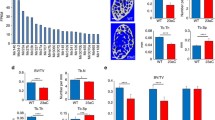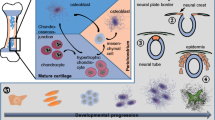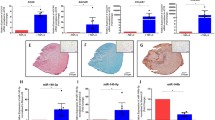Abstract
Purpose of Review
The role of microRNA (miR) regulation during the processes of bone homeostasis and remodeling has been a key research topic in recent years. Extensive work has gone into understanding the role of miR regulation in osteoblasts and osteoclasts; however, the role of miRs in osteocytes remains unclear. The aim of the present review is to describe the current knowledge regarding miR regulation in osteocytes.
Recent Findings
MiRs are key regulators of bone development and homeostasis, and the involvement of miRs in the regulation of osteocyte differentiation, viability, and function has recently been demonstrated. Findings from numerous studies have begun to identify various mechanisms of miR regulation in osteocytes. miRs have been shown to play a role in regulating osteocyte differentiation. For example, numerous miRs (including miR21, miR30, and miR23a) found to be upregulated during osteocyte differentiation target osteoblast-regulating mRNAs, whereas several downregulated miRs target key osteocyte-regulating genes. Further, miRs have been shown to regulate key signaling pathways controlling osteocyte viability and function. In particular, miR21 is involved in the survival signaling pathway downstream of connexin 43. Further, miR218, miR676, and miR324 regulate the expression of SOST/sclerostin, an osteocytic gene involved in the control of bone formation. Additionally, recent studies have demonstrated that miRs play a role in mediating cross-talk between osteocytes and other bone cells, as well as, with other musculoskeletal tissues including skeletal muscle and adipose tissue.
Summary
miRs have been shown to be involved in regulating osteocyte differentiation, viability, and function. Further, recent studies have begun to highlight the potential involvement of miRs in mediating extracellular communication/regulation between osteocytes and other cells within the musculoskeletal system. However, more research on this topic is needed to determine the extent to which miRs regulate osteocytes and whether they are also involved in mediating cross-talk between musculoskeletal cells.

Similar content being viewed by others
References
Papers of particular interest, published recently, have been highlighted as: • Of importance •• Of major importance
Bonewald LF. The amazing osteocyte. J Bone Miner Res. 2011;26:229–38.
Dallas SL, Prideaux M, Bonewald LF. The osteocyte: an endocrine cell ... and more. Endocr Rev. 2013;34:658–90.
Aguirre JI, Plotkin LI, Stewart SA, Weinstein RS, Parfitt AM, Manolagas SC, et al. Osteocyte apoptosis is induced by weightlessness in mice and precedes osteoclast recruitment and bone loss. J Bone Miner Res. 2006;21:605–15.
Kousteni S, Bellido T, Plotkin LI, O'Brien CA, Bodenner DL, Han L, et al. Nongenotropic, sex-nonspecific signaling through the estrogen or androgen receptors: dissociation from transcriptional activity. Cell. 2001;104:719–30.
Tomkinson A, Reeve J, Shaw RW, Noble BS. The death of osteocytes via apoptosis accompanies estrogen withdrawal in human bone. J Clin Endocrinol Metab. 1997;82:3128–35.
Weinstein RS, Jilka RL, Parfitt AM, Manolagas SC. Inhibition of osteoblastogenesis and promotion of apoptosis of osteoblasts and osteocytes by glucocorticoids: potential mechanisms of their deleterious effects on bone. J Clin Invest. 1998;102:274–82.
He X, Eberhart JK, Postlethwait JH. MicroRNAs and micromanaging the skeleton in disease, development and evolution. J Cell Mol Med. 2009;13:606–18.
van der Eerden BC. MicroRNAs in the skeleton: cell-restricted or potent intercellular communicators? Arch Biochem Biophys. 2014;561:46–55.
van Wijnen AJ, van de Peppel J, van Leeuwen JP, Lian JB, Stein GS, Westendorf JJ, et al. MicroRNA functions in osteogenesis and dysfunctions in osteoporosis. Curr Osteoporos Rep. 2013;11:72–82.
Kapinas K, Delany AM. MicroRNA biogenesis and regulation of bone remodeling. Arthritis Res Ther. 2011;13:220.
Zhang K, Barragan-Adjemian C, Ye L, Kotha S, Dallas M, Lu Y, et al. E11/gp38 selective expression in osteocytes: regulation by mechanical strain and role in dendrite elongation. Mol Cell Biol. 2006;26(12):4539–52.
Bonewald LF. Osteocytes as dynamic, multifunctional cells. Ann N Y Acad Sci. 2007;1116:281–90.
Dallas SL, Bonewald LF. Dynamics of the transition from osteoblast to osteocyte. Ann N Y Acad Sci. 2010;1192:437–43.
Eguchi T, Watanabe K, Hara ES, Ono M, Kuboki T, Calderwood SK. OstemiR: a novel panel of MicroRNA biomarkers in osteoblastic and osteocytic differentiation from mesenchymal stem cells. PLoS One. 2013;8:e58796.
Zeng HC, Bae Y, Dawson BC, Chen Y, Bertin T, Munivez E, et al. MicroRNA miR-23a cluster promotes osteocyte differentiation by regulating TGF-beta signalling in osteoblasts. Nat Commun. 2017;8:15000.
Moester MJ, Papapoulos SE, Lowik CW, Van Bezooijen RL. Sclerostin: current knowledge and future perspectives. Calcif Tissue Int. 2010;87:99–107.
Hassan MQ, Gordon JA, Beloti MM, Croce CM, Van Wijnen AJ, Stein JL, et al. A network connecting Runx2, SATB2, and the miR-23a~27a~24-2 cluster regulates the osteoblast differentiation program. Proc Natl Acad Sci U S A. 2010;107:19879–84.
You L, Pan L, Chen L, Gu W, Chen J. MiR-27a is essential for the shift from osteogenic differentiation to adipogenic differentiation of mesenchymal stem cells in postmenopausal osteoporosis. Cell Physiol Biochem. 2016;39:253–65.
Collette NM, Genetos DC, Economides AN, Xie L, Shahnazari M, Yao W, et al. Targeted deletion of Sost distal enhancer increases bone formation and bone mass. Proc Natl Acad Sci U S A. 2012;109:14092–7.
Kim SP, Frey JL, Li Z, Kushwaha P, Zoch ML, Tomlinson RE, et al. Sclerostin influences body composition by regulating catabolic and anabolic metabolism in adipocytes. Proc Natl Acad Sci U S A. 2017;114:E11238–47.
Guo Y, Tang CY, Man XF, Tang HN, Tang J, Wang F, et al. Insulin receptor substrate-1 time-dependently regulates bone formation by controlling collagen Ialpha2 expression via miR-342. FASEB J. 2016;30:4214–26.
Onal M, Piemontese M, Xiong J, Wang Y, Han L, Ye S, et al. Suppression of autophagy in osteocytes mimics skeletal aging. J Biol Chem. 2013;288:17432–40.
Fu J, Hao L, Tian Y, Liu Y, Gu Y, Wu J. miR-199a-3p is involved in estrogen-mediated autophagy through the IGF-1/mTOR pathway in osteocyte-like MLO-Y4 cells. J Cell Physiol. 2018;233:2292–303.
•• Davis HM, Pacheco-Costa R, Atkinson EG, Brun LR, Gortazar AR, Harris J, et al. Disruption of the Cx43/miR21 pathway leads to osteocyte apoptosis and increased osteoclastogenesis with aging. Aging Cell. 2017;16:551–63. This article shows the requirement of Cx43 and miR21 to maintain osteocyte survival and identified RANKL and HMGB1 as two molecules involved with elevated osteoclastogenesis. In addition, provides the first description of miR regulation via connexin in osteocytic cells.
Plotkin LI, Davis HM, Cisterna BA, Saez JC. Connexins and pannexins in bone and skeletal muscle. Curr Osteoporos Rep. 2017;15:326–34.
Bivi N, Nelson MT, Faillace ME, Li J, Miller LM, Plotkin LI. Deletion of Cx43 from osteocytes results in defective bone material properties but does not decrease extrinsic strength in cortical bone. Calcif Tissue Int. 2012;91:215–24.
Bivi N, Condon KW, Allen MR, Farlow N, Passeri G, Brun L, et al. Cell autonomous requirement of connexin 43 for osteocyte survival: consequences for endocortical resorption and periosteal bone formation. J Bone Miner Res. 2012;27:374–89.
Subramaniam M, Pitel KS, Bruinsma ES, Monroe DG, Hawse JR. TIEG and estrogen modulate SOST expression in the murine skeleton. J Cell Physiol. 2018;233:3540–51.
Davis HM, Aref MW, Aguilar-Perez A, Pacheco-Costa R, Allen K, Valdez S, et al. Cx43 overexpression in osteocytes prevents osteocyte apoptosis and preserves cortical bone quality in aging mice. JBMR Plus. 2018;2:206–16. https://doi.org/10.1002/jbm4.10035.
Pacheco-Costa R, Davis HM, Atkinson EG, Dilley JE, Byiringiro I, Aref MW, et al. Reversal of loss of bone mass in old mice treated with mefloquine. Bone. 2018;114:22–31.
Pacheco-Costa R, Davis HM, Sorenson C, Hon MC, Hassan I, Reginato RD, et al. Defective cancellous bone structure and abnormal response to PTH in cortical bone of mice lacking Cx43 cytoplasmic C-terminus domain. Bone. 2015;81:632–43.
Pacheco-Costa R, Davis HM, Atkinson EG, Katchburian E, Plotkin LI, Reginato RD. Osteocytic connexin 43 is not required for the increase in bone mass induced by intermittent PTH administration in male mice. J Musculoskelet Neuronal Interact. 2016;16:45–57.
An JH, Ohn JH, Song JA, Yang JY, Park H, Choi HJ, et al. Changes of microRNA profile and microRNA-mRNA regulatory network in bones of ovariectomized mice. J Bone Miner Res. 2014;29:644–56.
Zhang J, Chen H, Leung RKK, Choy KW, Lam TP, Ng BKW, et al. Aberrant miR-145-5p/beta-catenin signal impairs osteocyte function in adolescent idiopathic scoliosis. FASEB J. 2018;fj201800281. https://doi.org/10.1096/fj.201800281.
Plotkin LI, Pacheco-Costa R, Davis HM. microRNAs and connexins in bone: interaction and mechanisms of delivery. Curr Mol Biol Rep. 2017;3:63–70.
Lemcke H, Steinhoff G, David R. Gap junctional shuttling of miRNA--a novel pathway of intercellular gene regulation and its prospects in clinical application. Cell Signal. 2015;27:2506–14.
Varela-Eirin M, Varela-Vazquez A, Mateos MR, Vila-Sanjurjo A, Fonseca E, Mascarenas JL, et al. Recruitment of RNA molecules by connexin RNA-binding motifs: implication in RNA and DNA transport through microvesicles and exosomes. Biochim Biophys Acta. 2017;1864:728–36.
Zong L, Zhu Y, Liang R, Zhao HB. Gap junction mediated miRNA intercellular transfer and gene regulation: a novel mechanism for intercellular genetic communication. Sci Rep. 2016;6:19884.
Turchinovich A, Tonevitsky AG, Burwinkel B. Extracellular miRNA: a collision of two paradigms. Trends Biochem Sci. 2016;41:883–92.
Zhang J, Li S, Li L, Li M, Guo C, Yao J, et al. Exosome and exosomal microRNA: trafficking, sorting, and function. Genomics Proteomics Bioinformatics. 2015;13:17–24.
Abels ER, Breakefield XO. Introduction to extracellular vesicles: biogenesis, RNA cargo selection, content, release, and uptake. Cell Mol Neurobiol. 2016;36:301–12.
Ciardiello C, Cavallini L, Spinelli C, Yang J, Reis-Sobreiro M, de Candia P, et al. Focus on extracellular vesicles: new frontiers of cell-to-cell communication in cancer. Int J Mol Sci. 2016;17(2):175. https://doi.org/10.3390/ijms17020175.
Liu M, Sun Y, Zhang Q. Emerging role of extracellular vesicles in bone remodeling. J Dent Res. 2018;97:859–68.
Holliday LS, McHugh KP, Zuo J, Aguirre JI, Neubert JK, Rody WJ Jr. Exosomes: novel regulators of bone remodelling and potential therapeutic agents for orthodontics. Orthod Craniofacial Res. 2017;20(Suppl 1):95–9.
Morhayim J, van de Peppel J, Dudakovic A, Chiba H, van Wijnen AJ, van Leeuwen JP. Molecular characterization of human osteoblast-derived extracellular vesicle mRNA using next-generation sequencing. Biochim Biophys Acta. 2017;1864:1133–41.
Ge M, Ke R, Cai T, Yang J, Mu X. Identification and proteomic analysis of osteoblast-derived exosomes. Biochem Biophys Res Commun. 2015;467:27–32.
Li Q, Huang QP, Wang YL, Huang QS. Extracellular vesicle-mediated bone metabolism in the bone microenvironment. J Bone Miner Metab. 2018;36:1–11.
•• Sato M, Suzuki T, Kawano M, Tamura M. Circulating osteocyte-derived exosomes contain miRNAs which are enriched in exosomes from MLO-Y4 cells. Biomed Rep. 2017;6:223–31. This article demonstrates that osteocyte-released exosomes contain a particular pattern of miRs that can be detected in the circulating serum.
Morrell AE, Brown GN, Robinson ST, Sattler RL, Baik AD, Zhen G, et al. Mechanically induced Ca(2+) oscillations in osteocytes release extracellular vesicles and enhance bone formation. Bone Res. 2018;6:6.
Qin Y, Peng Y, Zhao W, Pan J, Ksiezak-Reding H, Cardozo C, et al. Myostatin inhibits osteoblastic differentiation by suppressing osteocyte-derived exosomal microRNA-218: a novel mechanism in muscle-bone communication. J Biol Chem. 2017;292:11021–33.
Qu B, Xia X, Yan M, Gong K, Deng S, Huang G, et al. miR-218 is involved in the negative regulation of osteoclastogenesis and bone resorption by partial suppression of p38MAPK-c-Fos-NFATc1 signaling: potential role for osteopenic diseases. Exp Cell Res. 2015;338:89–96.
• Xu Q, Cui Y, Luan J, Zhou X, Li H, Han J. Exosomes from C2C12 myoblasts enhance osteogenic differentiation of MC3T3-E1 pre-osteoblasts by delivering miR-27a-3p. Biochem Biophys Res Commun. 2018;498:32–7. This article identifies a mechanism of extracellular miR signaling between musculoskeletal cells and elucidates the downstream effects of muscle-derived factors on osteoblast activity.
Zhu CT, Li T, Hu YH, Zou M, Guo Q, Qu XW. Exosomes secreted by mice adipose-derived stem cells after low-level laser irradiation treatment reduce apoptosis of osteocyte induced by hypoxia. Eur Rev Med Pharmacol Sci. 2017;21:5562–70.
Moles R. MicroRNAs-based therapy: a novel and promising strategy for cancer treatment. Microrna. 2017;6:102–9.
Chakraborty C, Sharma AR, Sharma G, Doss CGP, Lee SS. Therapeutic miRNA and siRNA: moving from bench to clinic as next generation medicine. Mol Ther Nucleic Acids. 2017;8:132–43.
Funding
This research was supported by the National Institutes of Health R01-AR053643 to LIP. HMD is supported by an NIH T32-AR065971 grant.
Author information
Authors and Affiliations
Corresponding author
Ethics declarations
Conflict of Interest
The authors declare that they have no conflict of interest.
Human and Animal Rights and Informed Consent
This article does not contain any studies with human or animal subjects performed by any of the authors.
Additional information
This article is part of the Topical Collection on MicroRNAs in Skeletal Development
Rights and permissions
About this article
Cite this article
Plotkin, L.I., Davis, H.M. MicroRNA Regulation in Osteocytes. Curr Mol Bio Rep 4, 191–197 (2018). https://doi.org/10.1007/s40610-018-0102-1
Published:
Issue Date:
DOI: https://doi.org/10.1007/s40610-018-0102-1




